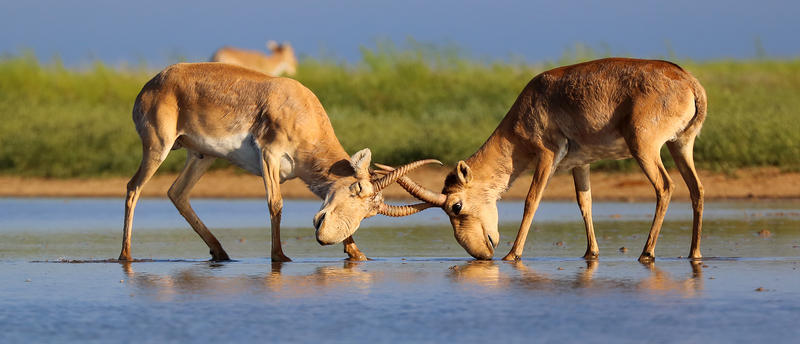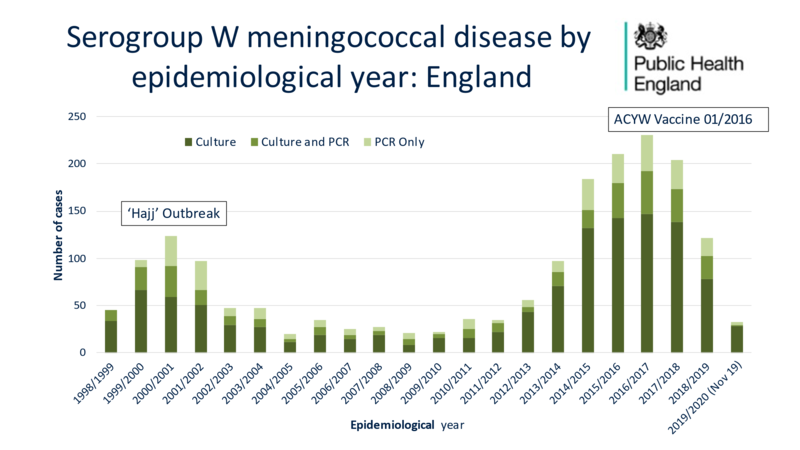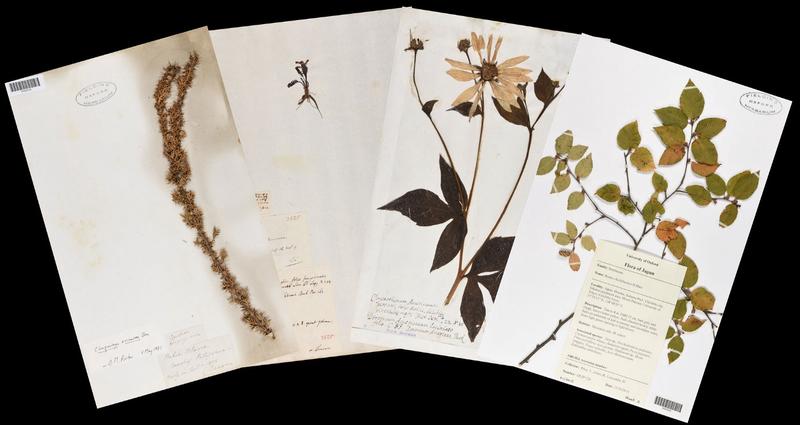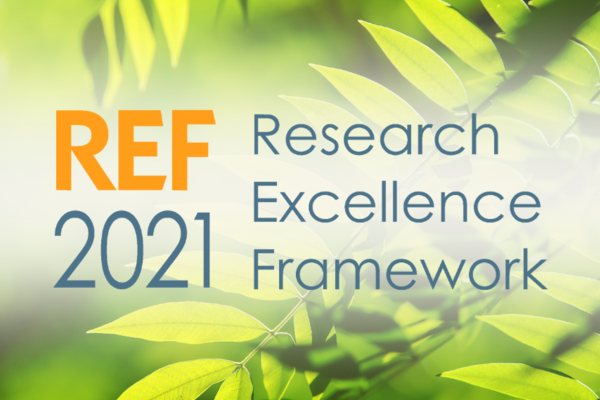Oxford Biology’s contribution to REF2021
See how Oxford Biologists performed in the UK’s Research Excellence Framework 2021
"Oxford is the biggest centre for biosciences research in the UK. The Biology participation in REF2021 is a testament to the quality of research being undertaken and real-world impact it has, whether that be in changing policy, or enhancing prosperity and societal wellbeing.
“We would like to thank all the people whose work underpinned the submission and helped produce the result that marks our research environment as world-leading."
EJ Milner-Gulland, Head of Department (Zoology) & Mark Fricker, Head of Department (Plant Sciences)
1. Helping to influence international policies to protect our woodland resources
Our reliance on forests, for timber, environmental services and food, can’t be understated. As a result, the understanding of how to improve conservation of forests, and the endangered species within them, is of utmost importance.
Research undertaken by Stephen Harris and David Boshier has investigated the extent to which isolation can reduce genetic flow between tree populations or individuals, and reduce population viability. Particular areas of research interest included:
- Showing the importance of trees on agricultural land for bridging the gap between different forest populations
- Demonstrating that no forest is ‘too small’ for conservation – even the smallest patch of woodland can help contribute to effective breeding between threatened tree species
- Assessing how different land uses, such as crops, or cattle pasture, can affect the genetic connectivity between forest patches more than the distance between patches does
- Developing models that can assess the chances of survival of tree species, based on associated land use, accessible habitat and distance between trees and forests
This has ultimately helped to inform policies and strategy implemented by the UN Food and Agriculture Organisation, and the Chilean, Canadian and UK governments around forest conservation, as well as leading training and forest management practice in new directions internationally.
Read more about this research here. See an example of how this research has been applied in Chile, in the conservation of the queule tree, in this video:
https://www.youtube.com/embed/GzmNjMu8470
2. Saving the saiga through public awareness and influencing policies
In 2015 the critically endangered saiga antelope suffered the most dramatic disease-related mass mortality experienced by a mammal. An interdisciplinary research team, co-led by EJ Milner-Gulland, diagnosed the cause of the mass mortality as a bacterial infection caused by abnormal weather. This research helped to contribute to the adoption of disease surveillance protocols for the species by the Government of Kazakhstan.
Conservation efforts for saigas since 2015, which were informed by this research, have contributed to the recovery of the Kazakhstan population by more than 200%. Fundraising for conservation that was assisted by the research has enabled projects in saiga areas including ranger patrols and community engagement.
Trade in products derived from saiga, particularly their horns, has been a long-term driver of poaching and international wildlife trade. University of Oxford research on demand for saiga products helped to inform the decision made in 2019 by the COP UN Convention on International Trade to impose a global zero quota on international trade in saiga antelope products. This work ultimately also helped to raise public awareness of this issue, and resulted in measurable impacts on the consumption and trade for saiga horn.
Read more about this work here.

3. Identifying strains of meningitis to rapidly influence policy and reduce cases
From 2009 onwards there was a sharp rise in cases of invasive meningococcal disease (IMD) in the UK and other countries, caused by a new strain of meningitis called “serogroup W Neisseria meningitidis (W:cc11)”. Whole genome sequencing (WGS) tools developed by Martin Maiden and colleagues at the University of Oxford were instrumental in allowing the rapid identification of the new strain as an aggressive strain that had originated in South America, providing an early indication that it had the potential to cause a serious UK outbreak.
By understanding more about the disease and its similarities to other strains, the team were about to directly influence a major change in UK national immunisation policy. The results included the introduction in 2015 of the MenACWY vaccine targeted at teenagers and young adults, resulting in the first use of this vaccine in Europe as part of a routine national immunisation schedule. At least 2,500,000 doses of the MenACWY vaccine were given in the first 4 years of the programme.
An estimated 6,000 cases of the new strain have been prevented by the vaccine over 5 years, with an estimated 720 lives saved. Following the success in the UK, the Netherlands, Canada and Ireland also added MenACWY vaccination to their immunisation schedules, supported by use of the WGS tools developed at the University of Oxford.
Read more about this work here

A graph showing the drop-off in serogroup W cases following the introduction of the MenACYW vaccine in the UK
4. A worldwide data management system helping to secure the future of plants

BRAHMS is a platform developed by Denis Filer and colleagues to help understand, manage and conserve plant diversity. The platform helps to manage the huge amount of plant data that exists, from plant name records, botanical and plant taxonomic information; all the way to specimen records held in herbariums.
It has now mobilised and integrated data from over 12 million specimens across national and international biodiversity networks.
The amalgamation of big data in this way has resulted in improvements to biodiversity policy and its monitoring in at least 60 countries, as well as identifying 34 new areas of high conservation value in the world – such as in Malaysia and Brazil.
BRAHMS has been adopted by major organisations such as the Millennium Seed Bank Partnership and Kew Gardens, helping to secure their invaluable global seed collections from flora across the planet. BRAHMS has also enabled global herbaria to undertake threatened species assessments and to meet commitments in conservation by integrating data into their management and planning.
Read more about this project here.
5. Shaping conservation policies and enhancing protection of threatened cat species
The University of Oxford Wildlife Conservation Research Unit (WildCRU) developed and applied a suite of analytical techniques to understand the distribution, ecology, population biology and vulnerability of the majority of the world’s cat species.
Using GPS and novel technologies to track different species, the team could monitor animal movement and the connectivity of populations. This allowed the multiple-scale modelling, with the implementation of AI methods, to assess different aspects of a species environment and their habits. Additionally, it allowed the team to assess how, if a scenario occurred where habitat was disrupted, how it may impact a species – allowing the team to identify key areas for protection.
The research has directly shaped land-use and conservation policies and practice across at least 15 countries in Asia, Africa and Europe. New conservation measures based on this research have helped to protect endangered and vulnerable cat species including clouded leopard species, the Indochinese leopard, African lion and Scottish wildcat, and entire ecosystems important for biodiversity and local populations have had improved protection.
Read more about this project here.
See an example of how this research has informed Myanmar’s decisions around development, in a way that helps to conserve wildcats, in this video:
6. Controlling dengue fever and other diseases with genetic modification technologies
Insects such as mosquitoes have long caused huge health problems through the transmission of infectious diseases like dengue fever. Techniques have been deployed to help prevent the spread of diseases, by reducing mosquito numbers, such as through the release of sterile adult mosquitoes into the wild to help control populations.
Luke Alphey’s research has led to the invention of self-limiting genetic modification tools for insects and the establishment of a successful spin out company, Oxitec Ltd. Since 2014, Oxitec has undertaken several successful trials in Brazil using two strains of genetically modified mosquitoes that have reduced the wild populations of mosquitoes in those areas (some have seen a reduction of up to 98%). In one of these field sites, a significant reduction in the number of cases of dengue fever was also recorded.
This technology has the potential to control multiple diseases, such as dengue, zika and chikungunya. Oxitec has already received approval from the US Environmental Protection Agency (EPA) to carry out further pilot projects to implement their technology, and potentially save many lives.
Read more about this project here.
7. Research leading to new major marine protected areas and advancing ocean & seabird conservation
Conservation of the oceans is a global priority, not just in terms of the preservation of marine biodiversity, but because of the central role that oceans play in the regulation of almost all the systems that make life on Earth possible. Seabirds play a key role in marine ecosystems and are important indicators of ocean health, as well as being amongst the most threatened and fastest declining taxa on Earth.
Seabird monitoring projects by Tom Hart, Dora Biro and Tim Guilford have been used to discovery the threats to marine habitats and ultimately led to the development of new marine protected areas at national and international level.
Seabird research groups have developed radical innovation to provide evidence-based recommendations for UK and overseas territories marine conservation areas and policies. Tom Hart's group has developed a data processing tool harnessing AI and citizen science to process big data on penguin monitoring while Tim Guilford group's has developed an integrated method of tracking small seabird species to better understand their behaviour. Crucially, on a national scale, this project has enabled the UK to meet obligations set out in the EU Birds Directive, and contributed to targets on conserving marine areas set by the UN. This research also provided evidence for the designation of one new marine Special Protection Area (Irish Sea), one new Marine Protected Area (South Georgia and South Sandwich Islands) and the proposed designation of one of the largest high-seas Marine Protected Areas in the northern hemisphere (Evlanov Seamount).
Read more about how this research contributed to understanding of penguin breeding dynamics and developed new, more accessible techniques for seabird monitoring.
See how work on penguin populations has been benefited by citizen science activities, and ultimately benefitted policies around conservation, in this video:

Image credit: Penguin Watch
8. Mitigating human-lion conflict through policy and community-based initiatives
University of Oxford research on trophy hunting and human-lion conflict in two globally important lion landscapes, in Zimbabwe and Tanzania, has actively informed management policy and conservation approaches at national, regional and global scales.
The research undertaken by WildCRU and their collaborators has informed government policy on lion conservation in several countries worldwide, and contributed to key international conservation (IUCN) guidelines.
Outcomes from this research have resulted in reduced critical conservation threats facing lions, including poorly managed trophy hunting and conflict with humans, in two globally important African lion population strongholds. The work has also seen measurable improvements to the livelihoods of local people through employment, education, healthcare, livestock protection, and food security, as a result of conservation action stemming from the research findings.
Read more about this research here.



